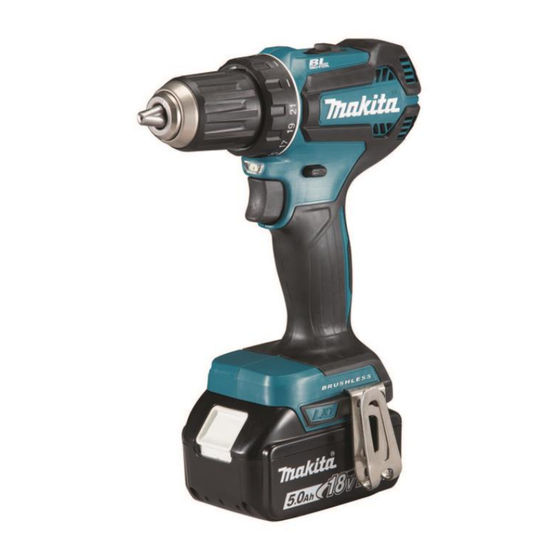
Makita DDF485 Repair Manual
Cordless hammer driver drill
Hide thumbs
Also See for DDF485:
- User manual ,
- Instruction manual (73 pages) ,
- Instruction manual (16 pages)
Advertisement
Quick Links
Advertisement

Summary of Contents for Makita DDF485
- Page 1 OFFICIAL USE For ASC CORDLESS HAMMER DRIVER DRILL DDF485 REPAIR MANUAL November 2018 Ver.1...
- Page 2 OFFICIAL USE For ASC CONTENTS CONTENTS ....................................2 CAUTION ....................................3 NECESSARY REPAIRING TOOLS ............................3 TIGHTENING TORQUE SPECIFICATIONS ..........................3 REPAIR ......................................4 Drill chuck ................................... 4 5-1-1 Disassembling ................................4 5-1-2 Assembling .................................. 6 Gear assembly, Rotor ................................7 5-2-1 Disassembling ................................
- Page 3 OFFICIAL USE For ASC CAUTION Repair the machine in accordance with “Instruction manual” or “Safety instructions”. Follow the instructions described below in advance before repairing: Wear gloves. In order to avoid wrong reassembly, draw or write down where and how the parts are assembled, and what the parts are. It is also recommended to have boxes ready to keep disassembled parts by group.
- Page 4 OFFICIAL USE For ASC REPAIR Drill chuck 5-1-1 Disassembling Remove Battery from the machine. Fig. 1 Remove M6×22 (-) Flat head screw [1] by turning it clockwise with Impact driver [2]. Tips Stable operation is available if you tighten the claws of Drill chuck with a Round - bit [3] in advance.
- Page 5 Use 1R359 to remove Drill chuck if it cannot be removed in the previous steps. The components of Gear assembly are as follows. Apply a small amount of Makita grease FA No.2 when you dismantle Gear assembly, if needed. Spur gear 17D...
- Page 6 OFFICIAL USE For ASC 5-1-2 Assembling Fig. 5 Assemble all component parts of Fig.4. Tighten four M3X30 Tapping screws [1] by using DF010D with Clutch position No.7. Fig. 6 Turn Drill chuck clockwise until it seats on the end of the threaded portion of Spindle. Fix the longer leg of Hex wrench 10 in the jaws of Drill chuck [1], then clamp L-shaped portion of Hex wrench 10 with Vise [2].
- Page 7 OFFICIAL USE For ASC Gear assembly, Rotor 5-2-1 Disassembling Disassemble Drill chuck according to process beforehand. (5-1-1) Fig. 7 Remove Housing R [2] by loosening eight 3x16 Tapping screws [1]. Fig. 8 Remove Gear assembly [1], Speed change lever [2], Motor section [3] from Housing L [4] at the same time.
- Page 8 OFFICIAL USE For ASC 5-2-2 Assembling Fig. 11 Rotor [1] is a strongly magnetic body. When handling or storing Rotors, therefore protect Rotors from deterioration due to the magnetic force as follows. Note Be sure to provide a proper distance between Rotors to Protect from: •Demagnetization by contact of Rotors.
- Page 9 OFFICIAL USE For ASC Fig. 13 Insert Motor section [1] into Gear assembly [2]. Fit the grooves [5] of Speed change lever [3] on both sides of Compression spring 4 [4] to the protrusions [7] of Gear assembly [6]. Fig. 14 Assemble Motor section with Gear assembly to Housing L by aligning the groove of Stator [1] with the projection on Housing L [2].
- Page 10 OFFICIAL USE For ASC Fig. 16 Fit the protrusion [1] of Switch lever in the groove [2] of F/R change lever. Fig. 17 Assemble Housing R [2] to Housing L with eight 3x16 Tapping screws [1]. Assembling of Leaf spring Fig.
- Page 11 OFFICIAL USE For ASC CIRCUIT DIAGRAM Fig. 20 Color index of lead wires' sheath White Gray Blue Black Yellow Orange LED circuit Stator Stator board AWG28 Straight receptacle Flag receptacle [with Lock/#250, t=0.8] [with Lock/#250, t=0.8] Connector Switch AWG28 AWG28 AWG14 AWG22 AWG28...
- Page 12 OFFICIAL USE For ASC WIRING DIAGRAM Fig. 21 Switch Connect Flag receptacle to Switch as illustrated. Put Connector Connector Stator in this space. Boss A Do not cross the thick lead Put Lead wires of LED circuit wires (Blue, White, Orange) between Ribs A and B, then connected to Stator between Rib C and Boss A.
- Page 13 OFFICIAL USE For ASC TROUBLESHOOTING Whenever you find any trouble in your machine, first, see this list to check the machine for solution. Note for Repairing Use a full charged battery which has a star mark. When Housing is disassembled, check the conditions of the electrical parts (Connectors, Lead wires, Switches, etc.), Rotor, Stator, Gear section, etc.
- Page 14 OFFICIAL USE For ASC 1R402-B Tips By attaching 1R402-B to each probe of 1R402, you can make your hands free for easier check. Note Be careful not to reverse them. The reversed contacts could spoil the test. 1R402-B Wait until the voltage value shown on the tester is stable, and then check the value. There is no problem with FET of Controller if the value is within the range of 0.7V -0.9V.
- Page 15 OFFICIAL USE For ASC Flowchart for Troubleshooting Check the items from the top of the following list. Note: Description of the item is referred to Circuit diagram. (6 CIRCUIT DIAGRAM) After corrective action, return to the start of Troubleshooting and re-check again. Symptom Cause Corrective action...












Need help?
Do you have a question about the DDF485 and is the answer not in the manual?
Questions and answers